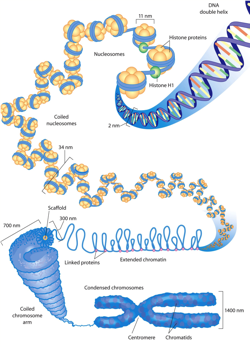“Sins of the Father” Revisited
For I, the LORD your God, am a jealous God,
punishing the children for the sin of the parents
to the third and fourth generation of those who hate me,
but showing love to a thousand generations of those
who love me and keep my commandments.
(Exodus 20:5b–6)
Sin has consequences and not just for the individual committing the acts of sin. Tragically, many times children and grandchildren suffer from the ill-conceived actions of their parents and grandparents, respectively.
As I proposed in the article “The Sins of the Father” (see New Reasons to Believe), new insights in epigenetics offer one way to scientifically explain how the sinful actions of parents, and even grandparents, can impact children for many generations. Recent work provides added support for my hypothesis.
Epigenetic Inheritance
Biologists now recognize that inheritance involves not only the transmission of genetic information (in the form of DNA sequences) from one generation to the next, but also the transmission of chemical modifications to the DNA (called epigenetic programming.)1 These modifications impact gene expression. (Gene expression refers to the overall gene activity of the cells making up a specific tissue, organ, etc. It can be thought of as an inventory of the genes that are “turned on”—directing the production of proteins—and the genes that are “turned off.” Gene expression also describes the quantity of different proteins produced as a result of gene activity.)
Environmental factors can alter the epigenetic modifications to DNA and, hence, influence gene expression patterns. And it turns out these DNA modifications can be inherited, impacting the offspring’s gene expression. In other words, epigenetic modification of the DNA caused by environmental factors can provide offspring with information about the situation their parents lived in at the time of the child’s birth.
Heterochromatin and Euchromatin
Researchers from Japan recently identified disruption of chromosome structure as an epigenetic mechanism that parents can transmit to their offspring.2 Chromosomal regions exist in differing states of condensation. Some areas are tightly packed; others are more diffuse. Biochemists refer to regions of tight packaging as heterochromatin and regions of light packaging as euchromatin. High levels of gene expression occur for genes located in the euchromatin areas. On the other hand, limited gene expression occurs in the tightly packed, highly condensed heterochromatin. (Watch this video for more details on chromosome structure.)

The Japanese researchers discovered that in the fruit fly Drosophila, a protein called ATF-2 (activation transcription factor-2) plays an essential role in forming heterochromatin. They also discovered that another protein (Mekk1-p38) chemically modifies ATF-2 when the cell experiences environmental stresses. This chemical modification (called phosphorylation) causes ATF-2 to be released from heterochromatin and, consequently, results in a disruption of the heterochromatin structure.
It turns out that the disruption can be transmitted to several subsequent generations, providing an additional mechanism by which the offspring can inherit epigenetic changes caused by environmental stresses.
Epigenetic Inheritance and Intelligent Design
Varying gene expression permits organisms to adapt to the environment, increasing their chance of survival. It would be extremely advantageous for offspring, which are likely to be born into the same surroundings as their parents, to be immediately adapted to the environment at the time of their birth.
Recent work by researchers from the United States and Israel illustrates this point. The investigators demonstrated that mice fed a low-protein diet sired offspring that displayed elevated expression of genes in the liver involved in producing fats and cholesterol and decreased levels of compounds called cholesterol esters when compared to mice fed a normal diet. The scientists also detected chemical modifications to the region of the mouse genome that regulates fat metabolism, which accounts for the altered gene expression.3
The observed metabolic changes lead to a hoarding of calories. If the parents go hungry, making the most of every calorie is critical for survival. It is also important for the offspring to stockpile calories, because again, they will likely be born into an environment with limited food supplies.
From a design perspective, epigenetic inheritance could be understood as reflecting the work of a Creator. Epigenetic inheritance represents a significant departure from the traditional view of inheritance. For nearly a century, scientists believed that, while organisms could respond to the environment during their lifetime, those adaptations could not be transmitted to their offspring. Yet, it is interesting that the Bible seems to teach the opposite (sins of the father): namely, environmental influences (in the form of behavior) can be inherited evoking confidence in the trustworthiness of Scripture.
Endnotes
- Eva Jablonka and Gal Raz, “Transgenerational Epigenetic Inheritance: Prevalence, Mechanisms, and Implications for Heredity and Evolution,” Quarterly Review of Biology 84 (2009): 131–76.
- Ki-Hyeon Seong et al., “Inheritance of Stress-Induced, ATF-2-Dependent Epigenetic Change, Cell 145 (2011): 1049–61.
- Benjamin R. Carone et al., “Paternally Induced Transgenerational Environmental Reprogramming of Metabolic Gene Expression in Mammals,” Cell 143 (2010): 1084–96.





